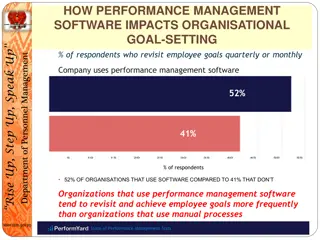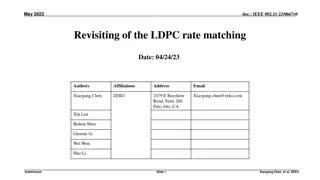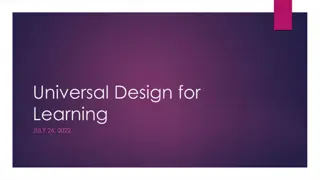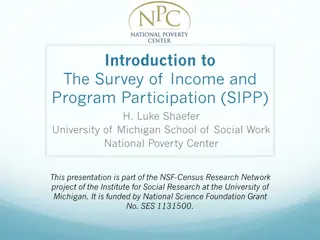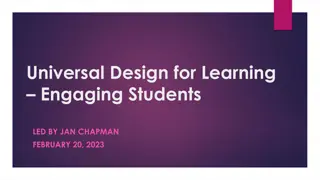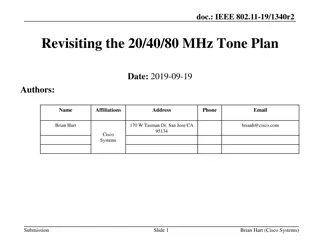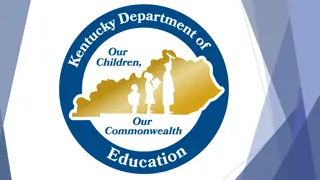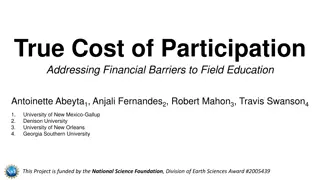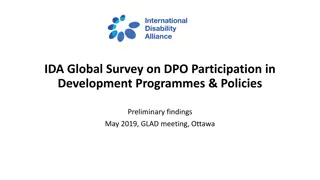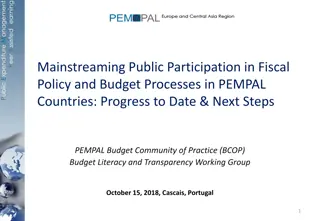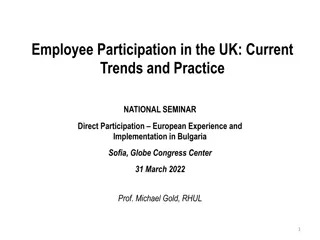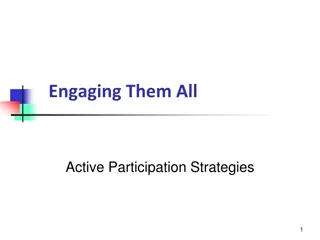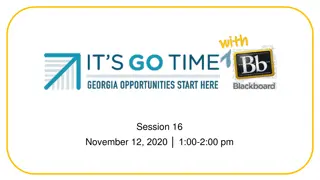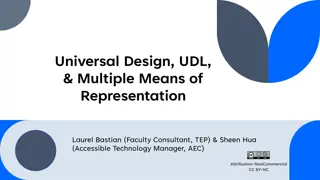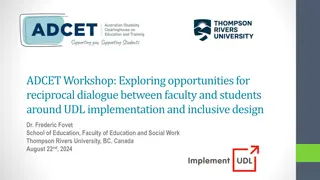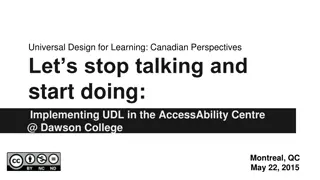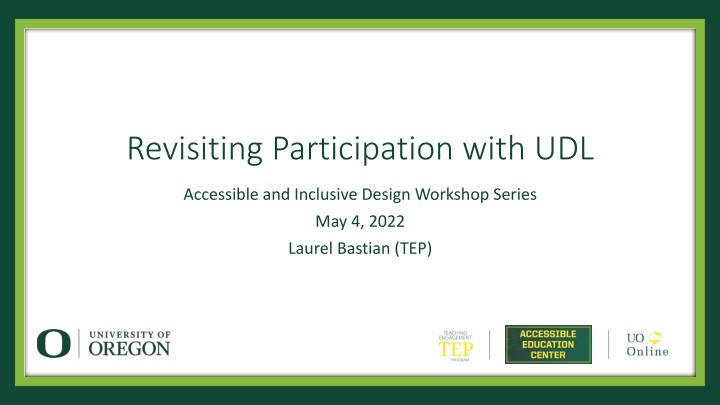
Enhancing Student Participation in Educational Settings
Explore the importance of student participation in academic environments through a workshop series on inclusive design, neurodiversity, and teaching strategies. Discover various forms of participation, its impact on learning outcomes, and ways to effectively engage students in the educational process. Join the conversation to enhance teaching practices and promote student success.
Download Presentation

Please find below an Image/Link to download the presentation.
The content on the website is provided AS IS for your information and personal use only. It may not be sold, licensed, or shared on other websites without obtaining consent from the author. If you encounter any issues during the download, it is possible that the publisher has removed the file from their server.
You are allowed to download the files provided on this website for personal or commercial use, subject to the condition that they are used lawfully. All files are the property of their respective owners.
The content on the website is provided AS IS for your information and personal use only. It may not be sold, licensed, or shared on other websites without obtaining consent from the author.
E N D
Presentation Transcript
Revisiting Participation with UDL Accessible and Inclusive Design Workshop Series May 4, 2022 Laurel Bastian (TEP)
Welcome! Before we get into our agenda, we invite you to think about your own experience with participation! Take a moment to consider the question below, then share some part of your reflection in the chat. What is/was your favorite way to participate (in classes, staff meetings, etc.)? What type of participation do you most look forward to and learn from?
Agenda (5) Welcome, outline of our time, guidance for session interaction (10) Identifying the what and why of participation (10) Defining neurodiversity & neurodivergence; seeing participation in context of neurodiversity (10) Recommendations from UO scholars and students (15) Revisiting your participation goals with UDL & student recommendations in mind
Participation: the what and why How is participation commonly defined and characterized? How can we tell if students are participating? Please take 2-3 minutes to reflect and write, this time in Padlet. You can find the Padlet link in the chat.
Participation: the what and why Though professors all tend to recognize class participation, and many use it in calculating students grades, what may or may not be counted as participation varies slightly with individual instructors and researchers. Participation can be seen as an active engagement process which can be sorted into five categories: preparation, contribution to discussion, group skills, communication skills, and attendance (Dancer & Kamvounias, 2005). It can come in many different forms, including students questions and comments (Fassinger, 1995b), and it can take a few seconds or an extended period of time (Cohen, 1991)." From "Student Participation in the College Classroom: an Extended Multidisciplinary Literature Review"
Participation: the what and why There is strong evidence for the importance of participating in class (Lyons, 1989; Petress, 2006; Weaver & Qi, 2005). Participation is a way to bring students actively into the educational process and to assist in enhancing our teaching and bringing life to the classroom (Cohen, 1991, p. 699). Students are more motivated (Junn, 1994), learn better (Daggett, 1997; Garard, Hunt, Lippert, & Paynton, 1998; Weaver & Qi, 2005), become better critical thinkers (Crone, 1997; Garside, 1996), and have self-reported gains in character (Kuh & Umbach, 2004) when they are prepared for class and participate in discussions.
Participation: the what and why I think there could've been more ways for more students to engage in the coursework. As the term continued, really the same people continued to participate with no new ones. Providing different opportunities for more engagement could've been improved. I think it would be helpful if the instructor moderated some in-class discussions a bit more. It's foreseeable that some of the topics covered could lead to sensitive issues, and I think it would be helpful if the instructor set some standards for constructive and respectful discussion, especially in terms of acknowledging the life experiences of underrepresented groups in class. Though participation is an important aspect of this class, the professor offers an alternative to speaking in class by allowing us to email him with our thoughts and have that counted as participation points. As someone who gets anxious trying to speak in a discussion class like this, this goes above and beyond... From Practitioner Guide: Inclusion
Participation: the what and why "Effective participation" is culturally constructed and subjective there is no universal norm. Cultural & perceptual differences include: Purpose of questions and expected responses (if response expected) Respectful ways to engage with questions, instructor, and peers Nonverbal cues that govern how/when we participate, such as timing, body language, hierarchy of roles Range of risk we assume when participating, in part due to identity within the cultural and social context of a class
Neurodiversity, Neurodivergence, & Participation Effective participation is culturally constructed and subjective. In many places in higher ed in the US, participation aligns with neurotypical norms. But our classes are neurodiverse, and we want to support all learners!
Neurodiversity, Neurodivergence, & Participation Neurodiversity is a term coined by Dr. Judy Singer, who said that Neurodiversity refers to the virtually infinite neuro-cognitive variability within Earth s human population. It points to the fact that every human has a unique nervous system with a unique combination of abilities and needs. Neurodiversity is a subset of Biodiversity, a term mostly used for the purpose of advocating for the conservation of species.
Neurodiversity, Neurodivergence, & Participation Dr. Nick Walker, in her essay Neurodiversity: Some Basic Terms & Definitions identifies three principles of what she and others term the neurodiversity paradigm : 1. Neurodiversity is a natural and valuable form of human diversity. 2. The idea that there is one normal or healthy type of brain or mind, or one right style of neurocognitive functioning, is a culturally constructed fiction, no more valid (and no more conducive to a healthy society or to the overall well-being of humanity) than the idea that there is one normal or right ethnicity, gender, or culture. 3. The social dynamics that manifest in regard to neurodiversity are similar to the social dynamics that manifest in regard to other forms of human diversity (e.g., diversity of ethnicity, gender, or culture). These dynamics include the dynamics of social power inequalities, and also the dynamics by which diversity, when embraced, acts as a source of creative potential.
Neurodiversity, Neurodivergence, & Participation Neurodivergent, also defined by Dr. Walker, means having a mind that functions in ways which diverge significantly from the dominant societal standards of normal. She goes on to say that: Neurodivergent is quite a broad term. Neurodivergence (the state of being neurodivergent) can be largely or entirely genetic and innate, or it can be largely or entirely produced by brain-altering experience, or some combination of the two.[ ] A person whose neurocognitive functioning diverges from dominant societal norms in multiple ways for instance, a person who is Autistic, dyslexic, and epileptic can be described as multiply neurodivergent.
Neurodiversity, Neurodivergence, & Participation As a recent AAC&U article notes, "about 9 percent of US children have been diagnosed with ADHD, 8 to 10 percent with a learning disability, and 2 percent with autism, according to federal statistics. All of these groups have higher rates of anxiety and depression than the general population. Our classes are neurodiverse spaces! From Neurodiversity is Diversity: How Educators Can Support Students Who Learn Differently
Neurodiversity, Neurodivergence, & Participation What wasn t shared about these definitions that matters to you? How might common ideas about what participation is and how we assess it rely on assumptions of neurotypicality or other cultural assumptions? Please do unmute or share your thoughts in the chat!
Neurodiversity, Neurodivergence, & Participation How do we more effectively engage students both neurodivergent and neurotypical students in participating in ways that support their learning? How can we think outside of our own cultural assumptions about participation? Let s listen to the recommendations of student-scholars
Recommendations from UO graduate scholars: Most of these come from Alex Newson & Spencer Brower, graduate students working with Dr. Geovanna Rodriguez (COE): Create consistency in class practices including participation. Share participation activities or questions ahead of time If using small groups, consider keeping groups stable across time Provide breaks, and let students know ahead of time when breaks will occur Be explicit about expectations and the how-to of participation Give explicit instructions for participatory tasks (ideally in multiple modes, verbally and in writing, for example) If using groups, identify roles students can take on to support clarity of group function If discussion is important, collaborate with students on a discussion agreement or class compact that makes the rules & goals of discussion explicit
Recommendations from UO graduate scholars: Most of these come from Alex Newson & Spencer Brower, graduate students working with Dr. Geovanna Rodriguez (COE): Design for student agency Find ways to surface and integrate students own goals for participation Presume that students know what they need for self-regulation & learning Make physical agency explicit note that students can leave when they need to, for example Minimize shock or surprise Do not cold call Build in time for reflection (1-2 min written or quiet thinking) before participation if questions meaningful and new Design ways to participate that allow for multiple modes of action and expression Reflect (with students!) on what worked during remote times in terms of participation, and how that can inform us know Where possible, design for choice in working solo or in a group
Recommendations: We can let students know that: 1. What effective participation means to each of us is culturally constructed and subjective not universal 2. That as a class you ll identify behaviors that all students should engage in (or refrain from) to support learning 3. Aside from these behaviors all will agree to engage in, they should expect difference in what participation might look and feel like, and that you value that difference
Pause and reflect Think back to what you wrote in Padlet about what participation is and how you know when students are participating. How do these recommendations make you think differently about what you/others wrote? There may be things you want to re-think--what tools do we have to design differently?
Designing for difference & agency with Universal Design for Learning (UDL) 3 Principles of UDL: provide multiple means of Engagement (the Engagement (the why why of learning) Representation (the what of learning) Action & Expression (the Action & Expression (the how of learning) how of learning) of learning)
Guideline: Multiple Means of Engagement ...learners differ markedly in the ways in which they can be engaged or motivated to learn. There are a variety of sources that can influence individual variation in affect including neurology, culture, personal relevance, subjectivity, and background knowledge... Some learners are highly engaged by spontaneity and novelty while others are disengaged, even frightened, by those aspects, preferring strict routine. Some learners might like to work alone, while others prefer to work with their peers. In reality, there is not one means of engagement that will be optimal for all learners in all contexts; providing multiple options for engagement is essential.
Guideline: Multiple Means of Action & Expression There is no medium of expression that is equally suited for all learners or for all kinds of communication [ ]While a learner with dyslexia may excel at story-telling in conversation, he may falter when telling that same story in writing. It is important to provide alternative modalities for expression, both to the level the playing field among learners and to allow the learner to appropriately (or easily) express knowledge, ideas and concepts in the learning environment.
UDL & your participation goals What is one of the most common ways you use participation to motivate or catch student interest? What other types of participatory activities could you use to motivate students or catch student interest? What is one of the most common ways you use participation to have students express what they know (or provide an accountability check for preparation)? What other participatory actions could students take to express what they know?
Identify what you want to apply: Based on our conversation today, what is one thing about your current participation policy you d like to revisit, even if you re not sure how you ll shift it? As you think about Universal Design for Learning, what is one additional participation opportunity you d like to build in for students that can broaden their choices about how to engage and show what they ve learned?
Resources Contact lbastian@uoregon.edu for co-thinking or consultation around designing more inclusive participation. The Accessible Education Center is available for faculty questions at 541-346-1155 or uoaec@uoregon.edu Schedule a consultation with TEP or UO Online any time at teaching.uoregon.edu
Thank you, and feel free to stay and chat!

